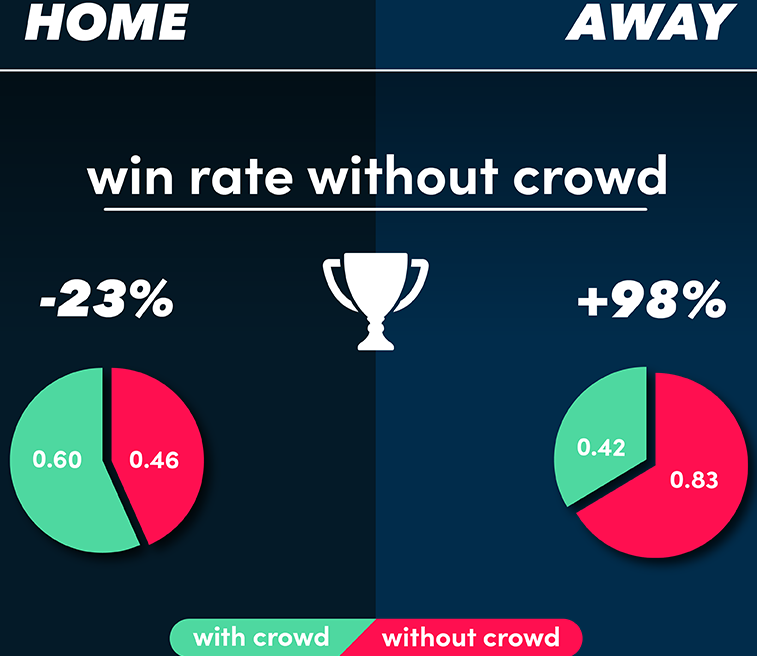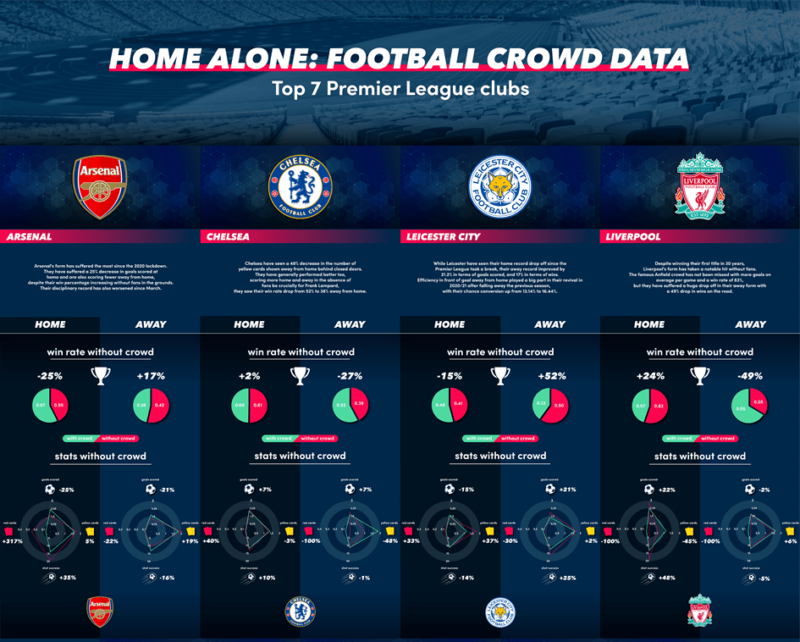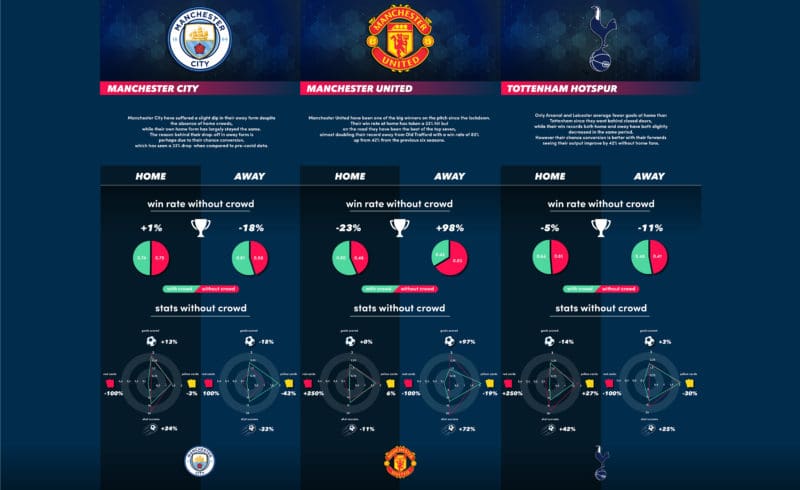
Home Alone: Football Crowd Data
Ever since the COVID-19 pandemic forced a temporary halt to the Premier League in March 2020, the game has changed.
Since then, fans have not been allowed inside the grounds of Premier League matches – save for a brief spell when up to 2,500 supporters were granted entry at various grounds – which meant matches were played in the absence of the usual atmosphere.
Football is all about the fans, so the noise provided by crowds plays a huge part in the overall product of the Premier League. Without it, players have had to get used to playing in front of empty stadia with just the club staff in attendance.
Click on the image to see full size.
Despite this sterile environment – which was so lacking in atmosphere that broadcasters had to add fake crowd noise to the background of their shows – the Premier League has continued at full pace following the hiatus, but how has the lack of crowds affected the product?
For starters, partisan home crowds are no longer able to influence a match as directly as they used to, and the lack of any atmosphere from the stands has seen the traditional notion of home advantage fall away with away teams generally enjoying more success than before.
Referees are supposed to be neutrals who are not swayed by the relentless noise (or abuse) from home or away support, but the latest data shows that the number of yellow and red cards given to home and away sides is now equal – whereas when there were fans allowed in grounds, away teams tended to be punished more by referees, possibly due to the pressure of home fans.
Sportmonks’ study, Home Alone: Football Crowd Data, has analysed all of the Premier League matches played behind doors from June 2020 to January 2021 and compared the results against the previous four seasons of data, to reveal whether player performance differs when there are crowds in attendance vs when stadiums are empty.
In total, 558 Premier League matches have been analysed to produce the results.
Overall, away teams are winning 20% more since lockdown last year than they were before when crowds were allowed in.
The average win rate for an away team stood at 30% previously but that has risen noticeably to 36%, while the home form has dropped from 45% to 40% – suggesting away teams are finding it easier to play away from home when there are no crowds to intimidate them.
There is also an increase in goals scored, with 1.34 goals scored per game by away sides now compared to 1.44 goals per game for home teams – figures which used to read 1.18 and 1.52 respectively – showing just how much more evenly balanced the game is without fans in the ground.
Another interesting statistic is the number of yellow cards shown by referees.
In the four-and-a-half seasons leading up to the lockdown, on average there were 1.59 yellow cards shown to home teams and 1.81 to away teams per game.
Those figures are much closer to each other without fans in the ground (1.54 v 1.51), suggesting that referees have a tendency to be swayed by crowd pressure and have performed better without fans.
Click on the image to see full size.
Sportmonks have also broken the data down by team, to show that Arsenal have seen the biggest drop off in form among the big seven teams in the league, scoring 25% fewer goals at home and 21% fewer away from home.
Manchester United have performed much better on the road without fans than they did before, scoring 97% more goals (2.66 per game) without fans in the grounds and winning a massive 83% of all away games in the matches analysed – up from 42%, representing a rise of 98%.
Liverpool’s recent struggles at Anfield have shocked everybody, and from June until the end of 2020 their home form had actually improved despite a lack of fans.
They were scoring 2.75 goals per game (up from 2.25) and winning 83% of their home matches (up from 67%), while their win rate away from home dropped massively from 55% to just 28%.
In fact, only Liverpool saw a real improvement in their home form during the period with no fans, with Manchester United, Tottenham, Leicester and Arsenal all dropping more points without fans in the ground.
Dane McCarrick, of University of Leeds School of Psychology and has recently conducted his own research into the subject, and commented on Sportmonks’ own research.
He said: “The home advantage phenomena has been long implicated in a number of sporting outcomes and I suppose what COVID-19 has done is allow us to look at this naturalistic observation of data.
“Supportive crowds are very much social representatives of the players and theory would say that they exert an invigorating or motivational influence upon players and encourage sides to perform well.
Click on the image to see full size.
“Therefore when you removed the crowd you would assume those performance outcomes are no longer as good.
“Equally, there has been evidence to show it impacts referees, so when you find out that the removal of fans has had a different or reduced effect on referees in some areas, it supports what we thought previously.
He added: The quality and skill level of the teams within these home advantage studies has differed. There’s some evidence to suggest that poorer teams may rely on their crowd more. It is as if this compensates in some way for the lack of skill, by leaning on the crowd or the support, and when that is removed they don’t do as well.
“When the fans are removed, there’s less attacking play. There is the point that you can push forward as an away team and take advantage of that; that might be going on here – home disadvantage, the idea that you feel pressure as the home team and when that’s removed you do better.
“But there’s also the fact that when you’re away from home you feel less pressure to perform well and you see these tendencies within the data.”
It remains to be seen whether teams’ performances will vary again as crowds return, but it is interesting nonetheless to see that crowd atmosphere is indeed a key factor in team success rates.
To access the full dataset and breakdown of Premier League figures, please get in touch.


